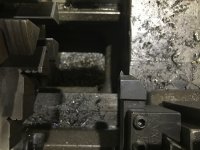Have a question for Jackie . How do you cut the shoulder when you set a barrel back with the threads already cut?


Thanks Chet[/QUOTE
The way I chamber makes it very easy to set a barrel back up exactly the way it came out on the initial chambering. So the threads and shoulder are running true.
Of course, it is impossible to reset a piece EXACTLY in the same position in a machine as it was on the initial machining where the setup was never disturbed. But the way I do it is so close my “tenth” indicator will barely pick it up.


